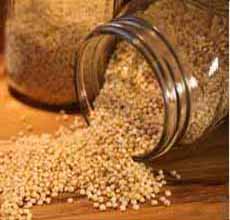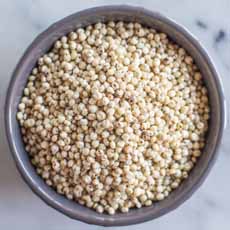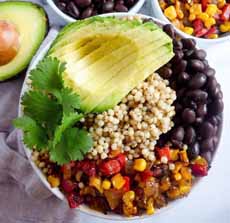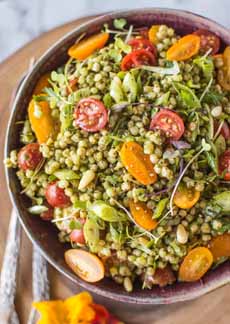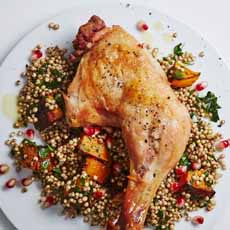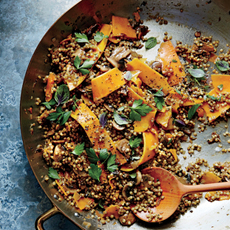TIP OF THE DAY: Cook Sorghum For Breakfast, Lunch & Dinner
|
When we first saw the word sorghum, it was as a tween, in the reading of “Gone With The Wind.” There was no sugar available in the blockaded, war-torn South, so Scarlett O’Hara sweetened her coffee substitute, chicory, with sorghum syrup, a molasses substitute. For decades, we thought of sorghum as a sweetener. After all, it’s not something you come across in the American diet. That is changing, with the rise in demand for gluten-free whole grains. Sorghum is an ancient Old World whole grain that has been cultivated for millennia. COOKING SORGHUM: WHERE TO START? Click to the links featured in the photos, and/or pick up a sorghum cookbook. WHAT IS SORGHUM? Sorghum is a genus of plants in the grass family—the family that includes the other grains (see the list below). Seventeen of the twenty-five sorghum species are native to Australia. One species, Sorghum bicolor, native to Africa, has become an important crop worldwide. Most varieties of sorghum are drought- and heat-tolerant, and are especially important crops in arid regions, where the grain is a dietary staples for the poor and rural populations. Sorghum is not only used for food (as grain and sorghum syrup, similar to molasses), but is brewed into alcoholic beverages, used as animal fodder, and made into biofuels. Nutritionally, it is similar to raw oats. A serving contains 20% or more of the Daily Value of protein; the B vitamins niacin, thiamin and vitamin B6; and several dietary minerals, including iron (26% DV) and manganese (76% DV). HULLED VS. PEARLED GRAINS When you see a grain labeled “hulled,” such as barley or sorghum, it indicates a whole grain. Hulled means that the the three parts of the seed—the bran, germ and endosperm—are intact, or “whole.” A whole grain provides optimum nutrition—vitamins, minerals and fiber. Only the inedible outermost layer, the hull, has been removed. This is true for all grains for human consumption: We can’t digest the hulls. Pearled grains are processed, like white rice. The polishing (pearling) removes the nutritious bran layer. The flavor is more delicate, not earthy; and it cooks faster. But a good amount of vitamins, minerals and fiber are lost in the process. Here’s more about whole grains and their nutrition. In 2012 Patricia Alemdar was given a taste of crushed sorghum from Haiti, where it’s considered a medicinal food. Although she liked the taste, she didn’t really care for the texture. (The common variety of sorghum is too dense to be cooked whole, so it needs to be crushed.) After months of research and testing, she and her mother produced a better, premium version of sorghum. It didn’t have to be crushed to be eaten whole. It had the softest bite and fastest cooking time. They launched it in 2014, and branded it Wondergrain. It’s a delicious addition to our table! The line is certified kosher by OU. Discover more at Wondergrain.com. ________________ |
[1] Sorghum (photo courtesy Wondergrain). [2] Pearled sorghum cooks faster, but is not a whole grain (see the discussion below—photo courtesy Healthy Nibbles And Bits). [3] BREAKFAST: A bowl of hot sorghum (here’s the recipe from Clean Eating Magazine). [4] LUNCH: Sorghum grain bowl with beans and avocado (here’s the recipe from Street Smart Nutrition). [5] Sorghum salad with kale pesto (here’s the recipe from Healthy Nibbles & Bits). [6] DINNER: Serve chicken or fish with a side of sorghum (here’s the recipe from Bon Appetit). [7] Add some grated cheese to this sorghum and squash pilaf (here’s the recipe from Cooking Light). |
|
|
†Salba is a trademarked name for chia, Kamut® is a trademarked name for khorasan wheat.
|
||
